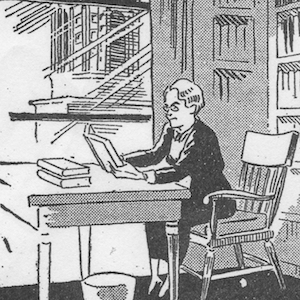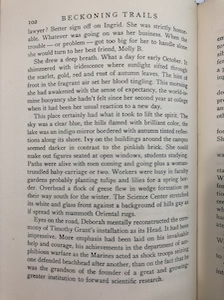
What most interests you in a book? The characters and plot? Memorable quotes? The sense of stepping into another world? Our recent guest post by Peggy in Illinois (See it here ) excited interest in spreadsheets to keep track of details about Emilie Loring’s books.
Below is a copy of Peggy’s spreadsheet with the titles, dates, and leading characters filled in. The next columns are labeled for the settings and plot lines, but they could be endlessly adapted, according to your interest. Maybe you’d like to include more characters or record Emilie Loring’s carefully-described interiors or gardens.

Over the course of this project, I have approached Emilie Loring and her books in many ways, each of which produced a different spreadsheet, real or virtual.
Without intending to, I spanned the outline of a literary criticism course I took at Trinity University. (Quick shout-out to my advisor, Dr. Harry B. Caldwell, who told me to take this senior-level course at the beginning of my freshman year–so helpful!) It’s been like looking through different lenses to appreciate different aspects of Emilie Loring and her writing.

Traditional
Traditional literary criticism evaluates the influence of a book and its author. Did it make a huge splash when it was published? Did its theme change public opinion? Did the author explore or perfect a new literary device? Is it so close to human experience that audiences will resonate with it across the ages?
Books that rise to the top enter the hallowed “literary canon,” that set of books known as “classics.” We read them in school, check them off on social media lists (“How many of these Classics have you read?”), and both recognize and use them in everyday conversations. Sheer popularity can vault a book into the nation’s cultural literacy, even if it does not belong to the canon. Gone With the Wind, for example, outsold the entire careers of more esteemed authors.
It’s the dickens for the biographer of an author outside these groups. One of my rejection letters read, “Emilie sounds absolutely fascinating, but alas I’ve never heard of her.” Of course, I was a perfect lady in my response, but inside, I seethed, “‘Absolutely fascinating’ and completely new–where is your curiosity?!”

Historical
Emilie Loring’s books invite a historical approach, published, as they were, each year from 1922 through 1951. An easy spreadsheet could track references in the books to national and world events for the months when they were written:
There Is Always Love, 1940: “It is hard to realize that across the ocean cities are being blacked-out through fear of an attack from the air.”
Where Beauty Dwells, 1941: “No matter what I am doing, all the time in the back of my mind I hear the beat of drums of war. One can’t ignore it in the life of today any more than one can a minor motif in a symphony.”
Rainbow at Dusk, 1942: “Japan has attacked Pearl Harbor. It looks like war at last.”
But of course, Emilie Loring lived forty-six years before she published an article, fifty-six before she published her first novel. I created one spreadsheet that tracks the addresses of seventeen members of her family, year by year, from 1843 to 1951. It took aeons to finish (or seemed like it), but what a useful reference to have as I uncovered events in Emilie’s life.
In the case of literary movements, Emilie Loring wrote during the Modern Period (1900-1950) which is known especially for stories of disillusionment and loss. But her books are more representative of the Realism Period of her youth and young adulthood, with an optimistic faith that people can make the world a better place.
“Men like you had better show up at the primaries and the polls, work to repeal the laws which you don’t like and substitute something better if you object to what you get.” Here Comes the Sun!
Hers was not a shallow optimism but a deep and abiding faith in the ultimate victory of the dragon-slayer.” Fair Tomorrow

Biographical
It’s only a small jump from the lens of historical events to a biographical one that explores events that directly impacted an author’s life. Clearly, that’s the approach I favor. It’s even in my working title, Happy Landings: The Life Behind Emilie Loring’s Stories.

Each colored bookmark represents a reference to a real occurrence in Emilie’s life–which makes sense, because what are our raw materials when writing if not the experiences we’ve had, the things we’ve learned? I’m also a firm believer in the idea that no book can be better than the character of the person who wrote it, that the impress of the author on a book is as unique as a fingerprint.
Social/Cultural/Political
Some approaches analyze relationships between segments of society. Emilie’s stories often showed relationships between the wealthy and working classes. And as a woman author with women protagonists, her stories can be mined for aspects of feminism–women’s roles as individuals, wives, mothers, citizens… and authors.
“I want a man who feels the responsibility of money and power. Wealth creates power, and to my mind responsibility.” Hilltops Clear
Jerry liked her dignity. She showed no consciousness of the difference between her three-room shack and the luxurious ranch-house from which the visitor had come. “Thoroughbred,” thought the girl as she preceded her hostess into a small but immaculately clean room. The Trail of Conflict
“You can do anything you want to do, Lindy. I hope you’ll want to be a grand wife and mother, but whatever it is never forget that your Dad believes you can be tops” There Is Always Love
Early in her business career she had discovered that the average man is susceptible to feminine headgear and shoes. As Long As I Live
Psychological
It can be a minefield to venture into the psychology behind an author’s works, but isn’t that what we do with a favorite author? We feel that we know her through her writing and want to know more: how she thought up ideas, weighed choices, made it through challenge and defeat. Emilie wrote love stories; don’t we want to know how she fell in love herself?
“My study of the motives behind actions has helped me understand the human heart—at least, my fans believe I understand it—I have seen that one-woman-in-the-world-for-me look in Tim’s eyes.” Beckoning Trails
The other side of a psychological approach is the reader’s response. This was Emilie Loring’s goal, after all, the reason she worked to perfect descriptions and create dialogues with a sense of immediacy.
“When I commence to tell a story, like the Ancient Mariner who held the Bridegroom with his skinny hand and glittering eye, I say to my reader:
‘Now listen. Don’t move till I get through.’”
Emilie Loring, radio interview
She captures our attention in the first lines of a story:
The French window in the library shook from the impact of a frenzied fist. It’s A Great World!
“Don’t refuse to see the boy, Claire.” The Solitary Horseman
Her foot was on the lowest step of the Pullman when she saw him striding toward the train. Love Came Laughing By
Then she doesn’t tell the story; she shows it.
“How long has this romance between you and Eve been going on, Jeff? How long have you been in love with her?”
“That’s the joke of the week, Uncle Jock, he hasn’t been in love with me at all.”
“Eve!”
At her first word Kilburn sprang to his feet and faced the girl standing back to the door.
It’s A Great World!
Formalist
Technique results in form, and the form itself affects the reader. Dialogues, for example, can be short volleys between characters, creating speed and momentum as the reader’s eye travels quickly down the page. Then, when a character is mulling something over, paragraphs become dense, and we slow down to match their reverie. Pace is everything in fiction, and Emilie controlled it with skill.
Genre
Emilie Loring’s stories don’t fit neatly into a fiction genre. She called her books “romance and adventure,” and they are romance, but not in the sense of Nora Roberts, and they are adventure, but not like The Hobbit or Harry Potter (See: Nope, Sorry, That’s Not Romance). When they were written, they were “contemporary fiction;” now that they have aged, are they historical fiction?
Happy Landings: The Life Behind Emilie Loring’s Stories is falling rather neatly into the genre of “literary biography.” The trick is to balance the author’s life and the author’s works in a narrative that is, itself, a compelling story.

“Imperative… is the presence of a storyteller, who introduces her-or-himself at the beginning of the book, steers the narrative through its exposition, and brings the story to a satisfying end.” (Biographer Diane Middlebrook, 2006)
With luck and a whole lot of work, the result will be complete enough to represent Emilie Loring as she was known in life and her works as they were created and endure today.
“The test is, how much do you want it? I’ve gone on that principle all my life, and it’s worked, I tell you, it’s worked!” The Trail of Conflict


I’m hoping to make a post here. I’ve put some thought into your post and have a few things to share. I’m trying to enjoy the breezy outdoors–sunny one minute cloudy the next. Too breezy for umbrella! Might rain too. Imagine that–near the Mississippi River! (Seriously, several smaller towns in the region have been evacuating. EL’s Swift Water’s climactic moment was a great flood.)
To the topic: I also created a couple of Word documents in which (1) I identified about 25 themes present in EL books. Of course, there’s marriage, war, free enterprise, “cheapness,” ,etc. I did list books which contained the theme. This document is a table that can be combined with my spreadsheet but I have not done so. (2) This second Word doc has 4 headings/topics under which I have jotted several bullets of my observations of differences between El originals and the “ghosties”. Topics are: leading male, leading female, plot development, and wealthy people. Those are just what jumped out to me.
I’m going to post this comment b/c of crazy weather and start a new post for a related topic prompted by your literary review post.
LikeLiked by 1 person
Another thoughtful comment from me will have to wait. Dinner and other things are up front tonight.
I will also note that I have some write ups on interesting situations/parallels in 2 or more novels. Some I didn’t have enough insight into and didn’t fully develop them. Others I think are pretty good. Patti posted some as guest blog posts.
LikeLiked by 1 person
Very educating, for me!
LikeLiked by 1 person
Wow! Patti this is an impressive literary post. I will need to read a few times to absorb it. You (and your prof) are right that there are several ways to critique/examine a novel or an author. Good idea to suggest that readers may want their own categories of notations beyond the titles, dates, and leading characters.
The daily battles of home and family life call at the moment….More later.
LikeLiked by 1 person
Wow, Patti, you have packed this post with a lot of information. Thank you for sharing more about our beloved Emilie and her work.
LikeLiked by 1 person
I made myself stop when I realized it was nearly 5:00, and I hadn’t had lunch yet. 🙂
LikeLiked by 1 person